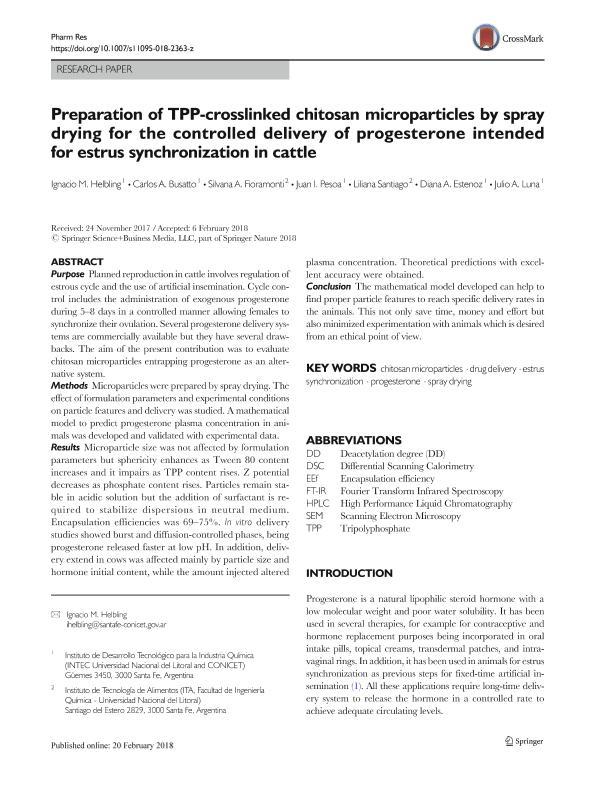Mostrar el registro sencillo del ítem
dc.contributor.author
Helbling, Ignacio Marcelo

dc.contributor.author
Busatto, Carlos Alberto

dc.contributor.author
Fioramonti, Silvana Alejandra

dc.contributor.author
Pesoa, Juan Ignacio

dc.contributor.author
Santiago, Liliana Gabriela

dc.contributor.author
Estenoz, Diana Alejandra

dc.contributor.author
Luna, Julio Alberto

dc.date.available
2019-10-21T17:16:57Z
dc.date.issued
2018-03
dc.identifier.citation
Helbling, Ignacio Marcelo; Busatto, Carlos Alberto; Fioramonti, Silvana Alejandra; Pesoa, Juan Ignacio; Santiago, Liliana Gabriela; et al.; Preparation of TPP-crosslinked chitosan microparticles by spray drying for the controlled delivery of progesterone intended for estrus synchronization in cattle; Springer/Plenum Publishers; Pharmaceutical Research; 35; 3; 3-2018; 1-15
dc.identifier.issn
0724-8741
dc.identifier.uri
http://hdl.handle.net/11336/86619
dc.description.abstract
Purpose: Planned reproduction in cattle involves regulation of estrous cycle and the use of artificial insemination. Cycle control includes the administration of exogenous progesterone during 5–8 days in a controlled manner allowing females to synchronize their ovulation. Several progesterone delivery systems are commercially available but they have several drawbacks. The aim of the present contribution was to evaluate chitosan microparticles entrapping progesterone as an alternative system. Methods: Microparticles were prepared by spray drying. The effect of formulation parameters and experimental conditions on particle features and delivery was studied. A mathematical model to predict progesterone plasma concentration in animals was developed and validated with experimental data. Results: Microparticle size was not affected by formulation parameters but sphericity enhances as Tween 80 content increases and it impairs as TPP content rises. Z potential decreases as phosphate content rises. Particles remain stable in acidic solution but the addition of surfactant is required to stabilize dispersions in neutral medium. Encapsulation efficiencies was 69–75%. In vitro delivery studies showed burst and diffusion-controlled phases, being progesterone released faster at low pH. In addition, delivery extend in cows was affected mainly by particle size and hormone initial content, while the amount injected altered plasma concentration. Theoretical predictions with excellent accuracy were obtained. Conclusion: The mathematical model developed can help to find proper particle features to reach specific delivery rates in the animals. This not only save time, money and effort but also minimized experimentation with animals which is desired from an ethical point of view.
dc.format
application/pdf
dc.language.iso
eng
dc.publisher
Springer/Plenum Publishers

dc.rights
info:eu-repo/semantics/openAccess
dc.rights.uri
https://creativecommons.org/licenses/by-nc-sa/2.5/ar/
dc.subject
CHITOSAN MICROPARTICLES
dc.subject
DRUG DELIVERY
dc.subject
ESTRUS SYNCHRONIZATION
dc.subject
PROGESTERONE
dc.subject
SPRAY DRYING
dc.subject.classification
Ingeniería Química

dc.subject.classification
Ingeniería Química

dc.subject.classification
INGENIERÍAS Y TECNOLOGÍAS

dc.title
Preparation of TPP-crosslinked chitosan microparticles by spray drying for the controlled delivery of progesterone intended for estrus synchronization in cattle
dc.type
info:eu-repo/semantics/article
dc.type
info:ar-repo/semantics/artículo
dc.type
info:eu-repo/semantics/publishedVersion
dc.date.updated
2019-10-18T18:06:48Z
dc.journal.volume
35
dc.journal.number
3
dc.journal.pagination
1-15
dc.journal.pais
Estados Unidos

dc.journal.ciudad
New York
dc.description.fil
Fil: Helbling, Ignacio Marcelo. Consejo Nacional de Investigaciones Científicas y Técnicas. Centro Científico Tecnológico Conicet - Santa Fe. Instituto de Desarrollo Tecnológico para la Industria Química. Universidad Nacional del Litoral. Instituto de Desarrollo Tecnológico para la Industria Química; Argentina
dc.description.fil
Fil: Busatto, Carlos Alberto. Consejo Nacional de Investigaciones Científicas y Técnicas. Centro Científico Tecnológico Conicet - Santa Fe. Instituto de Desarrollo Tecnológico para la Industria Química. Universidad Nacional del Litoral. Instituto de Desarrollo Tecnológico para la Industria Química; Argentina
dc.description.fil
Fil: Fioramonti, Silvana Alejandra. Universidad Nacional del Litoral; Argentina
dc.description.fil
Fil: Pesoa, Juan Ignacio. Consejo Nacional de Investigaciones Científicas y Técnicas. Centro Científico Tecnológico Conicet - Santa Fe. Instituto de Desarrollo Tecnológico para la Industria Química. Universidad Nacional del Litoral. Instituto de Desarrollo Tecnológico para la Industria Química; Argentina
dc.description.fil
Fil: Santiago, Liliana Gabriela. Universidad Nacional del Litoral; Argentina
dc.description.fil
Fil: Estenoz, Diana Alejandra. Consejo Nacional de Investigaciones Científicas y Técnicas. Centro Científico Tecnológico Conicet - Santa Fe. Instituto de Desarrollo Tecnológico para la Industria Química. Universidad Nacional del Litoral. Instituto de Desarrollo Tecnológico para la Industria Química; Argentina
dc.description.fil
Fil: Luna, Julio Alberto. Consejo Nacional de Investigaciones Científicas y Técnicas. Centro Científico Tecnológico Conicet - Santa Fe. Instituto de Desarrollo Tecnológico para la Industria Química. Universidad Nacional del Litoral. Instituto de Desarrollo Tecnológico para la Industria Química; Argentina
dc.journal.title
Pharmaceutical Research

dc.relation.alternativeid
info:eu-repo/semantics/altIdentifier/doi/http://dx.doi.org/10.1007/s11095-018-2363-z
Archivos asociados
